
Deposition Date
2005-06-06
Release Date
2005-11-29
Last Version Date
2024-10-30
Entry Detail
Biological Source:
Source Organism:
Enterobacteria phage P1 (Taxon ID: 10678)
Host Organism:
Method Details:
Experimental Method:
Resolution:
2.98 Å
R-Value Free:
0.29
R-Value Work:
0.24
R-Value Observed:
0.24
Space Group:
P 62 2 2


